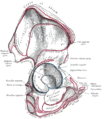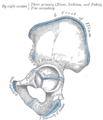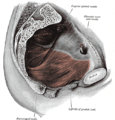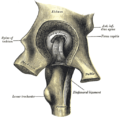Pubis (bone)
In vertebrates, the pubis or pubic bone (Latin: os pubis) forms the lower and anterior part of each side of the hip bone. The pubis is the most forward-facing (ventral and anterior) of the three bones that make up the hip bone. The left and right pubic bones are each made up of three sections; a superior ramus, an inferior ramus, and a body.
Pubis (bone)
Other animals[edit]
Mammals[edit]
Non-placental mammals possess osteological projections of the pubis known as epipubic bones. These evolved first among derived cynodonts, and evolved as a means of support for muscles flexing the thigh, facilitating the development of an erect gait.[5] However, these prevent the expansion of the torso, preventing pregnancy and forcing the animal to give birth to larval young (the modern marsupial "joeys" and monotreme "puggles").[6]
Placentals are unique among all mammals, including other eutherians, in having lost epipubic bones and having been able to develop proper pregnancy. In some groups, remnants of these pre-pubic bones can be found as os penises.[7]
Dinosaurs[edit]
The clade Dinosauria is divided into the Saurischia and Ornithischia based on hip structure, including importantly that of the pubis.[8] An opisthopubic pelvis is a condition where the pubic bone extends back towards the tail of the animal, a trait that is also present in birds.[9] In a propubic pelvis, however, the pubic bone extends forward towards the head of the animal, as can be seen in the typical saurischian pelvic structure pictured below. The acetabulum, which can be thought of as a "hip-socket", is an opening on each side of the pelvic girdle formed where the ischium, ilium, and pubis all meet, and into which the head of the femur inserts. The orientation and position of the acetabulum is one of the main morphological traits that caused dinosaurs to walk in an upright posture with their legs directly underneath their bodies.[10] The prepubic process is a bony extension of the pubis that extends forward from the hip socket and toward the front of the animal. This adaptation is thought to have played a role in supporting the abdominal muscles.








